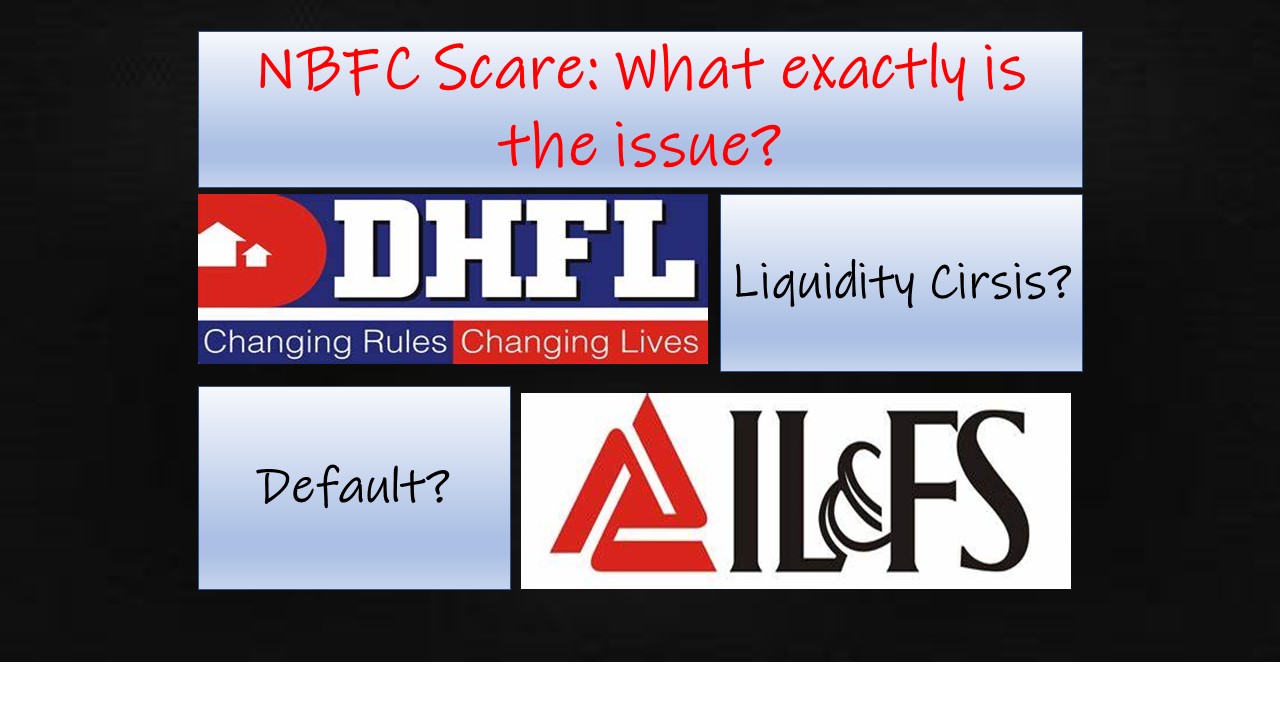
Last updated on July 24th, 2021 at 04:53 pm
NBFC scare: What exactly is the issue?
What is NBFC / HFC? and How they are different from banks?
NBFC or Non-banking financial companies (NBFCs) are financial companies without any banking license. These institutions offer various banking services but cannot open savings accounts / current account etc or accept deposits from the public. However, an NBFC can offer other banking services such as loans and credit facilities, retirement plans, investment plans, money markets, underwriting and merger activities, etc. There are different types of NBCFs like; Asset Finance Company, Infrastructure Finance Companies, Loan Companies, Gold Loan Companies, etc.
HFCs or Housing Finance Companies are also non-banking financial institutions offering credit facilities like Home loans, mortgage loans etc. In short, these companies provide
credit facilities pertaining to Real Estate.
There are various Micro-Finance Institutions (MFIs) that provide financial services to the low-income population. Many MFIs have registered themselves as NBFCs.
Who regulates NBFCs?
NBFCs including HFCs provide certain banking facilities like loans etc without any banking license. And, the non-availability of the banking license keeps them outside the purview of certain banking regulatory requirements. NBFCs have been exempted from the requirement of registration under Section 45-IA of the RBI Act, 1934 subject to certain conditions; however, RBI being the apex regulatory authority in India, monitors and creates various norms/rules to regulate the issues caused by NBFCs. Housing Finance Companies are regulated by the National Housing Bank, Insurance companies are regulated by the Insurance Regulatory and Development Authority (IRDA) whereas other venture capital companies, etc are regulated by SEBI.
What is the issue?
In September 2018, India’s one of the biggest NBFC, – Infrastructure Leasing & Financial Services (IL&FS) defaulted on a series of its coupon payments.
Around the same time, a large fund manager sold short-term bonds issued by a housing finance company named Dewan Housing Finance Ltd. (DHFL) at a sharp discount.
Both these incidents triggered a huge question on credibility and liquidity issues with NBFCs and HFCs and havoc in the stock markets was evident.
After this, DHFL issued statements clarifying their credit ratings or no default done by the company, etc. but the news about the liquidity crunch faced by these NBFCs kept stirring the market. News of IL&FS stopping the payments to contractors and going bankrupt confirmed the liquidity crunch faced by the company.
Over the past couple of years, the NBFC sector has witnessed rapid growth. NBFCs loan book grew almost 21% in the Fiscal year ending March 18 whereas the bank loan grew around 10% over the same period. While NBFCs offer loans to the public at large, it gets funding from large corporates and mutual funds by issuing Commercial Papers (CPs) or bonds. A steep shortfall in funding received against the loans offered by NBFCs can create an “Asset Liability mismatch (ALM)” and confirms the liquidity issues faced by NBFCs. This also increases the cost of funding of the NBFCs and can in-turn further create liquidity issues.
Analysts have flagged the emergence of ALM-related risks at NBFCs especially those dealing in Infrastructure Finance. ICRA had already issued concerns about the NBFCs on June 18 and predicted the cost of funding to grow by 45bps.
Rating agency Moody’s Investors Service believes that this liquidity tightness can lead to higher financing costs or even further defaults by NBFCs as they will face difficulties in rolling over their liabilities.
In addition to all this, the recent financial results declared by top companies i.e. Infosys and TCS reveal that they have favored investing their surplus funds in banks rather than liquid funds. The liquid funds invest a significant amount in CPs of NBFCs especially infrastructure companies.
All this has created a huge scare in the market as the defaults by the company highlights the risk of a sharp growth slowdown. Further, as the lenders reduce their exposure to NBFCs in India, the losing investor confidence is evident. All this, coupled with other economic adverse conditions like rising crude prices, increasing interest rates, inflation, depreciating rupee, etc deeply hampers the macro-economic growth of the country.
What is the cure?
NBFCs are clarifying their liquidity positions to gain investor confidence. However, defaults by IL&FS and reduction in exposure to NBFCs still questions the liquidity crunch. Hence RBI aims at introducing measures to create enough liquidity in the market.
In October 2018, RBI did not raise its interest rates as a rate hike can take away the liquidity available in the market. (To know more read Why does RBI hike interest rate?)
In last week, RBI announced an easing of some liquidity coverage norms by initiating the fund flow to NBFCs.
RBI, in its efforts to ease liquidity, also permitted banks to reckon government securities held by them to their incremental outstanding credit to NBFCs and HFCs
In short, RBI is gearing up and taking all the measures to tackle the liquidity crunch faced by NBFCs / HFCs.
Will RBI get success in creating enough liquidity to NBFCs / HFCs? Let us know what do you feel by commenting below.
You may also like :
- Let’s understand how the PCA norms help RBI to bring financial stability in the country?
- What is the cause for rift between RBI & Govt. of India ?
- The US may remove India from Currency monitoring list
- Why does RBI hike interest rate?
- A relationship between the Stock Market and Dollar/Rupee
- How to do a transaction in Digital Rupee (CBDC-R)? – A Step by step Guide - 10/12/2022
- Can you rectify your 26AS? - 20/09/2022
- Tax implications on Cashback - 09/09/2022
Disclaimer: The above content is for general info purpose only and does not constitute professional advice. The author/ website will not be liable for any inaccurate / incomplete information and any reliance you place on the content is strictly at your risk.
Follow us on Social Media by clicking below
Follow @financepost_in


Be the first to comment